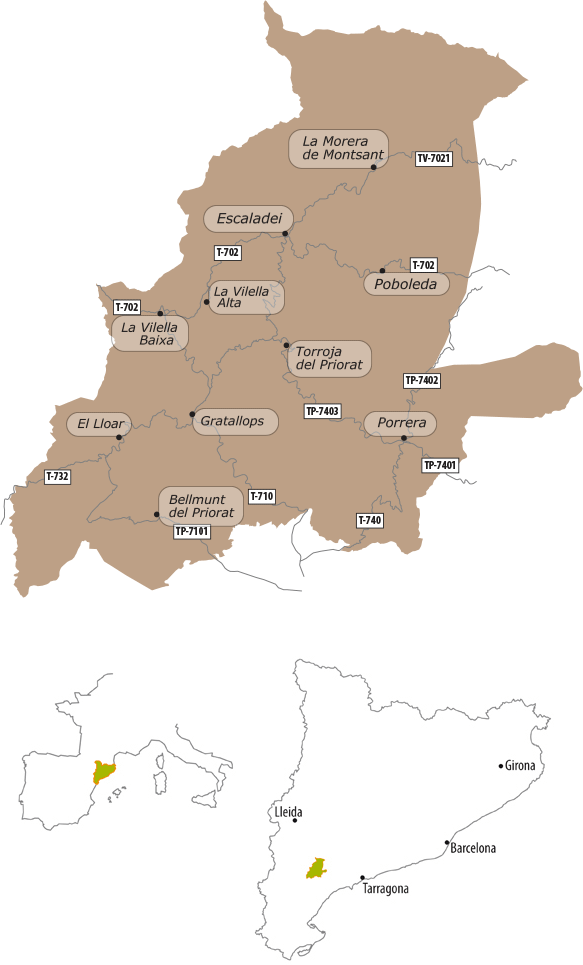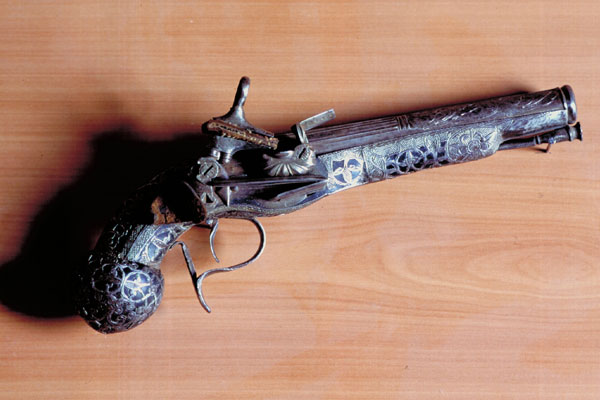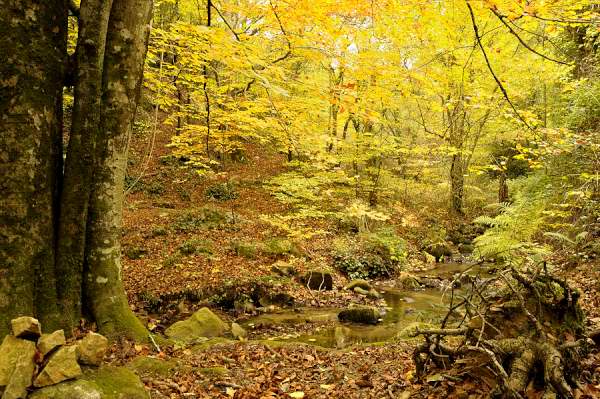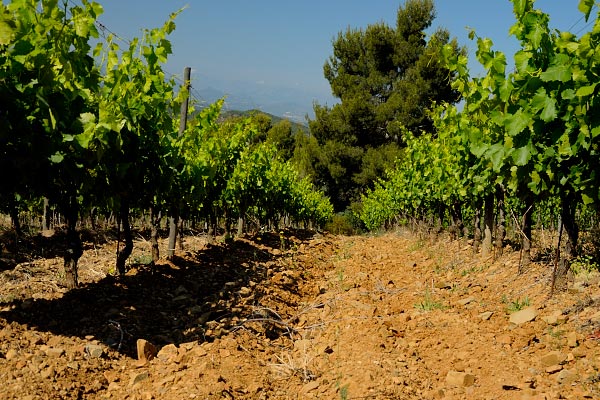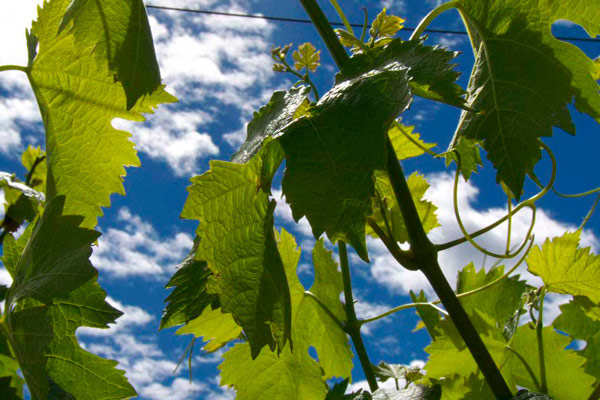
The Priorat wine: talking about Priorat is talking about wines
The Priorat wine
Talking about Priorat is talking about wines
The Priorat wine, where is it?
The Priorat is a region located in the South of Catalonia. The wine area called Priorat is in the administrative region called Priorat. Both have the same name, but are not the same place. The wine area (DOQ Priorat) makes up 28% of the administrative region and covers 17,629 hectares.
Above you can see the Priorat wine area. The capital of the Priorat administrative area is Falset, but Falset sits outside the Priorat wine area.
The Priorat administrative region has 23 municipalities but only nine are part of the Priorat wine area. They are La Morera de Montsant (Escaladei belongs to La Morera), Gratallops (capital of the wine area), Porrera, Poboleda, Torroja del Priorat, La Vilella Alta, La Vilella Baixa, El Lloar and Bellmunt del Priorat. A part of Falset and the eastern part of El Molar also belong to the Priorat wine area.
Production and grapes of the Priorat wine
23% of the wine made in Spain comes from Catalonia. Catalonia has 780 wineries (104 in the Priorat wine area) and 12 designations of origin (DO).
Only 0.83% of the wine produced in Catalonia comes from the Priorat. More than 80% of Priorat wine is exported to other countries, such as USA, Canada, Switzerland, Germany, Belgium and the Netherlands.
When it comes to grapes, in the Priorat the red varietals account for 95% of the total production, so I am going to ignore the white varietals in this article.
Up to 1980 only the two local varietals were harvested: Garnacha and Cariñena. Both varietals complement each other. The Garnacha gives flavour and alcohol strength and the Cariñena contributes body and acidity.
The arrival of René Barbier and his friends brought the introduction of new grape varietals. In 2013, the distribution of red-wine varietals was:
— Garnacha: 42%
— Cariñena: 22%
— Cabernet sauvignon: 15%
— Syrah: 11.5%
— Merlot: 8%
— Others: 1.5%
In the Priorat the minimum level for alcohol by volume is 13.5%.
Each red-wine varietal has different characteristics:
Garnacha
Ripens mid-season.. It can cope with poor and dry soils. Sensitive to fungus. High production levels (though the older the vine, the lower the production)
High alcohol strength. Low acidity. Few tannins. Colour intensity: low-moderate (the older the vine, the higher the colour)
Flavouring: red fruits in young wines; ripe fruits, old wood and cacao in aged wines.
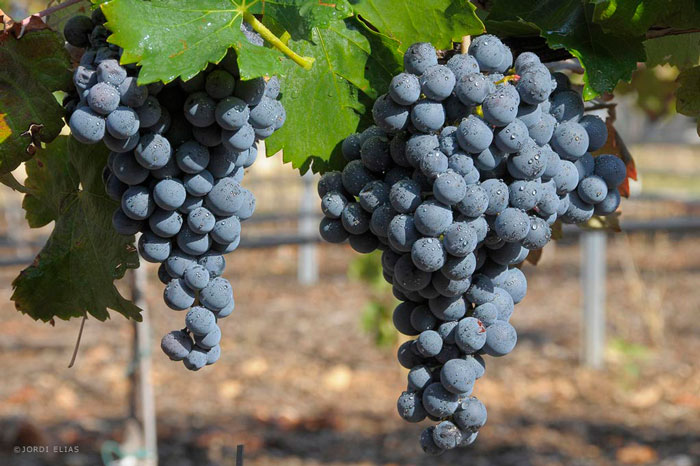
Cariñena
Also called Samsó (in Catalan). Late ripening. It can cope with dry soils and draughts but it is sensitive to fungus. High productivity.
Alcohol strength: moderate-high. High acidity. High level of astringent tannins. Good colour intensity.
Flavouring: neutral.
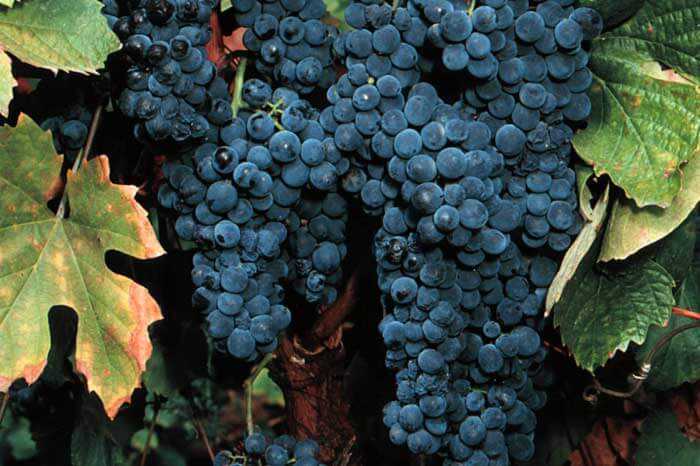
Cabernet sauvignon
Comes from Bordeaux. Late ripening. Sensitive to dry soils, though less so than Merlot and Syrah. Also sensitive to fungus. It is the least productive red-wine varietal.
High level of alcohol strength. Medium- level acidity. The high level of complex tannins makes it ideal for aged wines. High colour intensity.
Flavouring: green pepper. As a result of these characteristics, the wines are very structured.
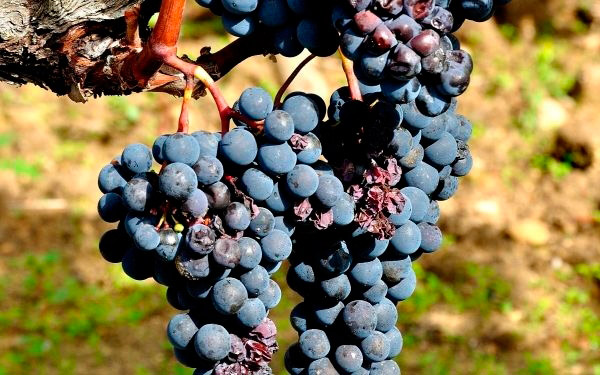
Syrah
Early ripening. It cannot cope with dry soils. Vines have higher productivity than Cabernet.
Alcohol strength: moderate to high. Medium-level acidity. High level of tannins and colour intensity. Useful for both young and aged wines.
Flavouring: violet and red fruits.
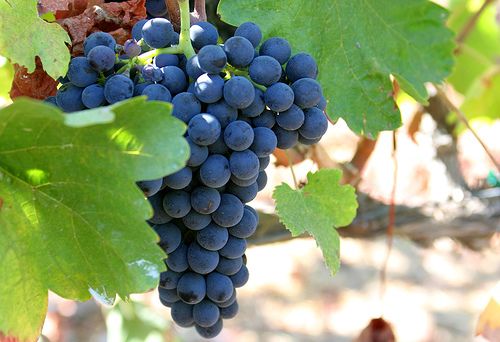
Merlot
Ripens mid-season. Does not like dry soils. Higher productivity than Cabernet.
High alcohol strength. Medium- level acidity. High level of tannins which makes it suitable for aged wines. High level of colour and well structured.
Flavouring: black pepper, green pepper and forest fruits. Merlot makes wines creamy.
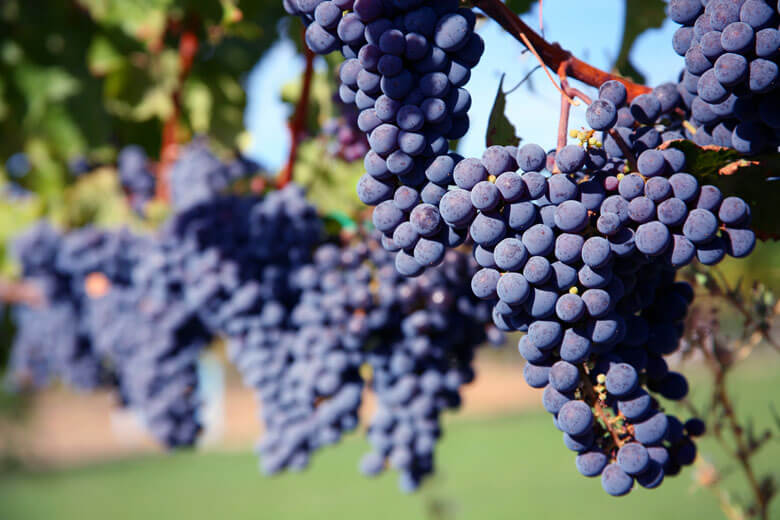
Grape ripening of the Priorat wine
In the Priorat the terrain is hilly so the vines are planted either on hill slopes (costers in Catalan) or in terraces. Terraces are used when the slope is too steep. The oldest vines (at least 80 years old) are planted in costers. The youngest are farmed on terraces. Vines are between 200m and 700m above sea level.
If you imagine the slope of a hill in the Priorat (whether in coster or terrace farming) where the elevation gain between the base and the top is at least 100m, the production of the vines located at the top is a third or half of the vines at the base of the hill.
Because of erosion, the depth of the soil at the top of the hill is thinner than at the base. At the top, the grape reaches the desired alcoholic strength earlier than at the base; the opposite applies to acidity. This forces the farmer to harvest the vineyard over three different weeks, depending on the ripeness level of the grapes.
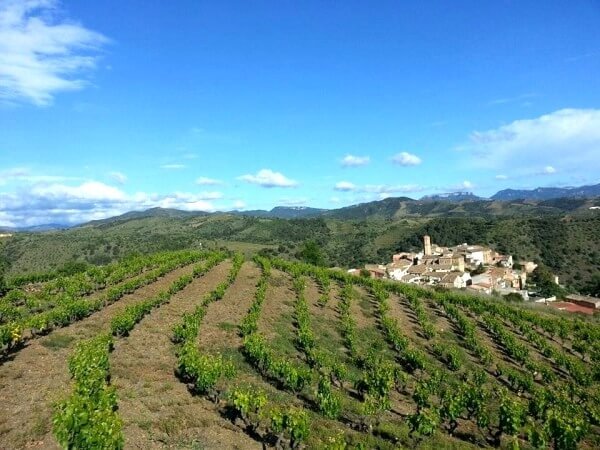
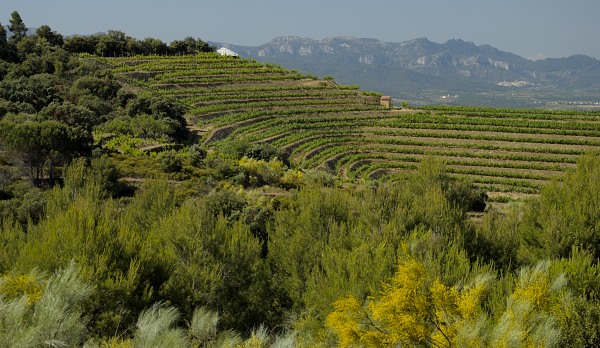
Usually terraces are so narrow that the vineyard cannot be worked with farm machinery. Harvest yields are very low (less than 1kg of grapes per vine).
The harvest usually starts the first or second week of September and can continue until late October.
The order in which red-wine varietals are picked is as follows: Syrah, Merlot, Garnacha, Cabernet and Cariñena.
Climate and geology of the Priorat
The climate in the Priorat is temperate, Mediterranean, and dry, with hot summers and cold winters. The average temperature is 14°C and the average rainfall is between 450 and 650mm.
In spring and autumn the temperature changes dramatically between night and the day. Autumn is the season when it rains more.
During some dry periods vines in the Priorat have been irrigated but never when the grapes are ripening. Because of the good weather, fungal infections are less frequent than in other wine areas of Catalonia or Spain. That means a low level of chemical treatments, and those used are very environmentally friendly. The most common disease is Uncinula necator (more information here), which is treated with sulphur.
The soil is the most distinctive feature of the Priorat. It is shallow (usually the bedrock is only 10-15cm underneath) and is made of llicorella, a metamorphic shale rock. It is a kind of slate, greyish or brownish, flat-shaped, foliated, that can be easily broken up in sheets. Nearly all soil in DOQ Priorat is llicorella.
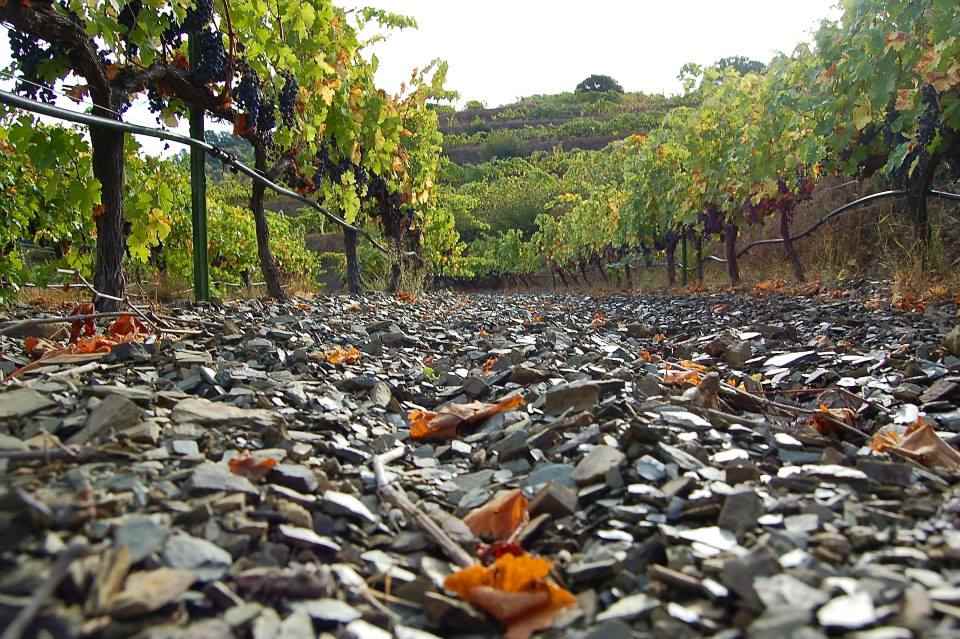
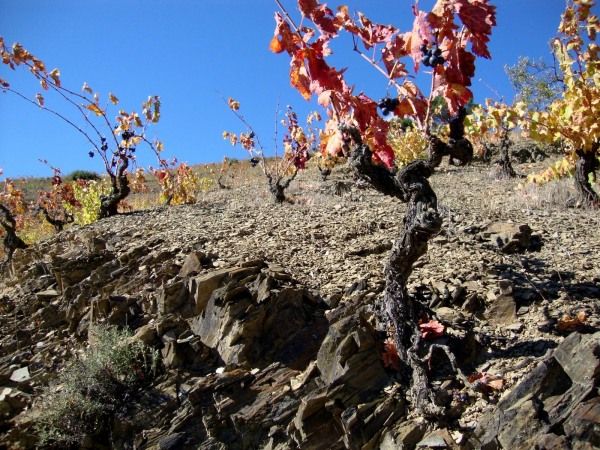
Llicorella soils have low fertility and are well-drained, and as a result the grape has a lot of sugar and tannins. That is to say, the wines have strong alcohol levels and are structured and persistent. To learn more about llicorella click here.
The terroir, the combination of the climate and the soil, determines the wine.
To learn more go to History of the Priorat and The Priorat‘s “Miracle”
Please comment below on The Priorat wine: talking about Priorat is talking about wines.
If you wish to travel to the Priorat and see the most beautiful spots in this part of Catalonia – see the cycling and walking tour we have for you or contact us here for any Tours questions you might have.


